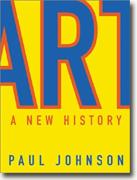Art: A New History
Paul Johnson
book reviews:
· general fiction
· chick lit/romance
· sci-fi/fantasy
· graphic novels
· nonfiction
· audio books
· author interviews
· children's books @
curledupkids.com
· DVD reviews @
curledupdvd.com
newsletter
win books
buy online
links
home
for authors
& publishers
for reviewers

 |
Art: A New History Paul Johnson HarperCollins Hardcover 792 pages September 2003 |
|
Even the title of this big bold book has elan - sweep the old dusty volumes off the shelves, here comes a new history of art!
It seems important to him, for instance, that we know that, of Rubens, "There is never any hint of meanness or jealousy, undue pride or anger over money and commissions; just fair dealing, good fellowship and endless kindness." Whereas of Whistler he imparts, "He gobbled publicity. When he quarreled with a friend, as he always did in the end, he leaked the news to the gossip columns...he was an odious man." Johnson's approach is personal. In the early portion of a long paragraph on the thousands of life-sized clay warriors unearthed in China, he suddenly asks, "Is this art?" and further along responds to his own query, "Here was a demonstration not so much of art as of centralised power to mobilise and set to work the elements of a vast design." Is this opinion? And how does Johnson's view of the Chinese warriors and their creation by a centralized power compare with his clear adoration of the great William Morris of whom he dotes admiringly, "His career tells us two important things about art. The first is that, in seeking to improve taste, financial independence is important...the fact that Morris ran the firm, and ran it with great commercial acumen, allowed his taste and ideas to prevail absolutely." (I never found the second thing). This in praise of a man who, as Johnson fairly reports, invented a the eponymous chair in which he refused to sit, and when told that people found it uncomfortable, said "They can go to bed." Being an opinionated reviewer myself, I like some of Johnson's notions. I believe he has visited the Alhambra in Granada, as I have, or else how could he so intimately report the satisfaction of "its sense of airy lightness, reassuringly underwritten by marmoreal solidity. When the throng of visitors departs, water is the only sound, broken occasionally by the cries of ravens above." The book is somewhat dismissive of Picasso (as are many) and rushes through Impressionism, that discipline beloved of those who don't know art but know what they like. But this is forgivable in that he has a long way to go, from prehistoric caves to downtown Los Angeles in his search for aesthetic production. But when he makes a momentary stop along the way, it is often to great effect, particularly as his mastery of prose is unhampered by the need to please anyone as much as himself. Thus was I introduced to Ilya Repin (1844-1930) whom Johnson calls "Russia's most significant painter." The example put before us is a painting entitled "They Did Not Expect Him," depicting a man returning from Siberian exile, a "ragged, emaciated, unshaven figure" entering the parlor of a middle-class home. "His wife, facing us, looks up in astonishment. His children, doing their homework, are amazed...his elderly mother - is it, perhaps, the personification of Mother Russia? - rises from her chair and fixes her gaze on her son." Johnson baldly states, "This is one of the greatest paintings produced in the nineteenth century...a work people will turn to in hundreds of years' time, for an answer to the question, What was it like?" An amateur painter himself, Johnson admits he has always wanted to write this book, and in his introduction sets out his ground rules. Art is a paradoxical tension between the need of the artist for freedom to express himself, and the demands of the patrons and audience, who pay the bills, to make things look or feel a certain way. Art often breaks new ground. "...the greatest artists ...do things a new way." And sweep us along. This book will raise eyebrows and make much matter in coffeehouses across the English-speaking world. It is almost certain that everyone who reads it, or merely diligently picks through as in a guidebook to the subject, will have favorite sections. Whether they will want to admit to this or not is another question, one that I suspect Paul Johnson would himself gladly debate.
|
|
|
|
 Click here to learn more about this month's sponsor! |
|
| fiction · sf/f · comic books · nonfiction · audio newsletter · free book contest · buy books online review index · links · · authors & publishers reviewers |
|
| site by ELBO Computing Resources, Inc. | |
 Paul Johnson, an historian of prodigious output, has blessed us with this new way of looking at the old -- sometimes the ancient -- with different eyes. He is irreverent, often biased, and tends to as much examination of the private lives of artists as of their work.
Paul Johnson, an historian of prodigious output, has blessed us with this new way of looking at the old -- sometimes the ancient -- with different eyes. He is irreverent, often biased, and tends to as much examination of the private lives of artists as of their work.